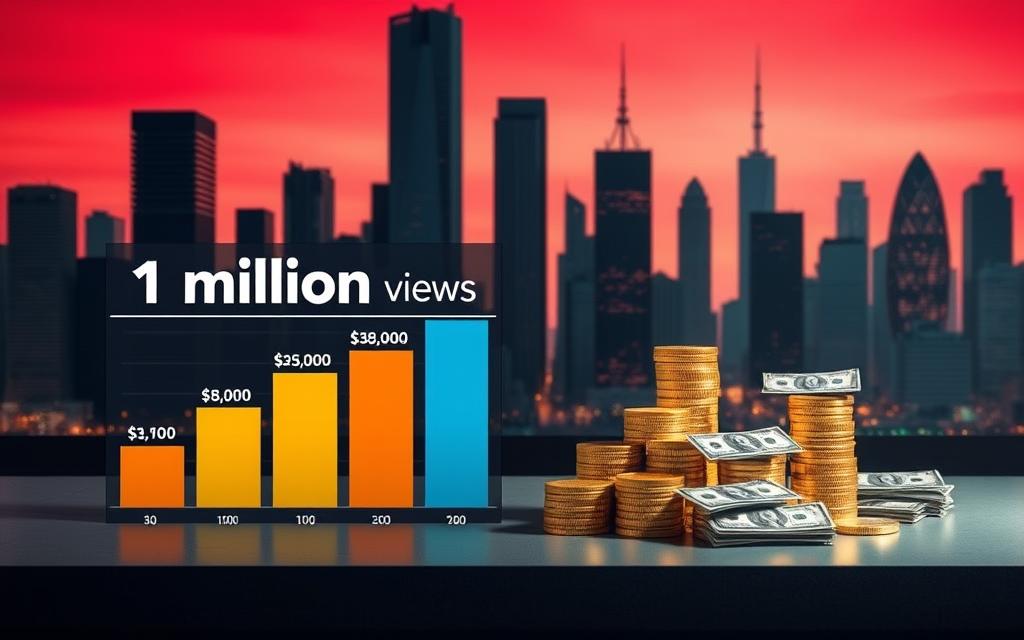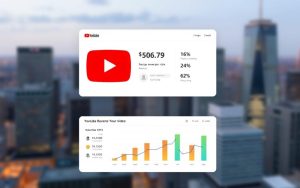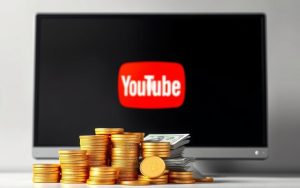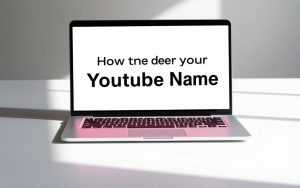Table of Contents
Many creators wonder about the financial potential of viral content. While earnings vary widely, popular videos can generate substantial revenue. The amount depends on multiple factors, including niche, audience location, and ad performance.
On average, high-performing videos earn between $3,000 and $5,000 per million plays. However, top creators in lucrative niches like finance or tech often see much higher returns. For example, Joseph Hogue’s channel earns over $20,000 for the same view count.
YouTube takes a 45% cut from ad revenue, leaving 55% for creators. Diversified income streams, such as sponsorships and merchandise, significantly boost earnings. Seasonal trends also play a role, with holiday periods often increasing payouts.
Success on the platform requires more than just views. Strategic monetization and audience engagement are key to maximizing income.
Understanding YouTube’s Payment Structure
Successful creators master two key metrics that determine their ad revenue. These numbers reveal how much money your content generates and where opportunities for growth exist.
CPM vs. RPM: Key Metrics Explained
CPM (Cost Per Mille) measures what advertisers pay per 1,000 impressions. A $10 CPM means brands spend $10 for every thousand ad views. This advertiser-side metric varies by niche, with finance content often commanding higher rates.
RPM (Revenue Per Mille) reflects creator earnings after YouTube’s 45% cut. If your CPM is $10, your RPM becomes $5.50. Premium subscribers boost RPM further, as their ad-free views still contribute to your revenue.
YouTube’s 55/45 Revenue Split
The platform keeps 45% of ad money, passing 55% to creators. For example:
| Niche | Average CPM | Creator RPM |
|---|---|---|
| Education | $5–$15 | $2.75–$8.25 |
| Finance | $16.23 | $8.93 |
Google AdSense tracks these metrics in real time. Watch time also matters—videos under 8 minutes rarely qualify for mid-roll ads, reducing earning potential.
Strategic creators optimize content length and audience demographics to maximize per mille rates. A tech reviewer earning $20 RPM makes $20,000 per million views—four times more than a gaming channel at $5 RPM.
How Much Does 1 Million Views on YouTube Pay?
A million plays can mean $2,000 or $30,000—here’s why. Earnings fluctuate wildly based on niche, audience demographics, and content format. While some creators celebrate life-changing payouts, others see modest returns for the same view count.
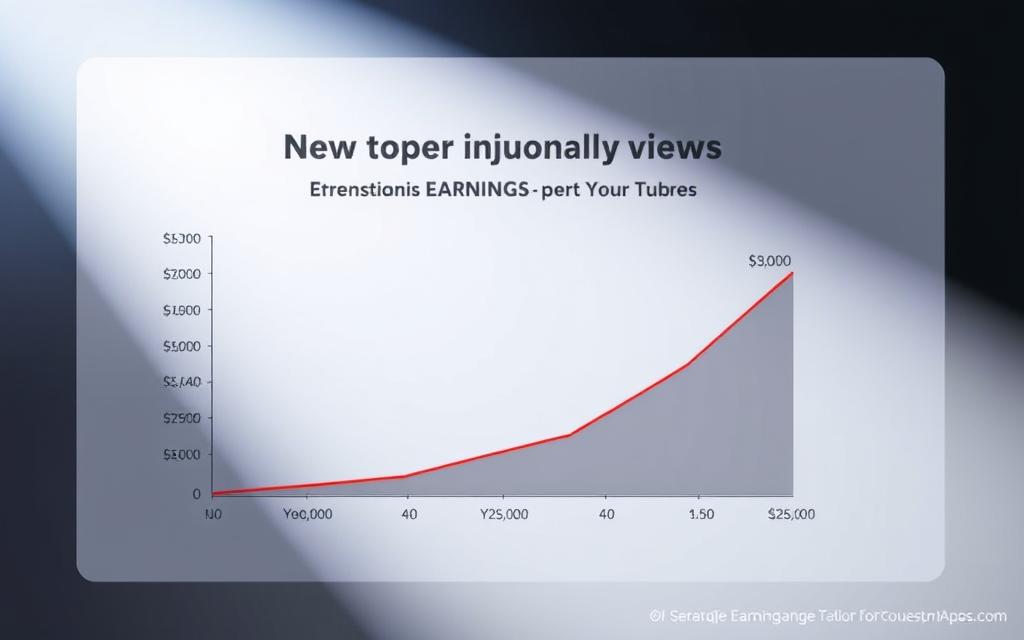
Average Earnings Range
Most channels earn $3,000–$5,000 per million plays from ads alone. However, niches like gaming average just $2,000, while finance creators like Joshua Mayo report $29.30 RPM—nearly 15× higher. This gap stems from advertiser demand and audience purchasing power.
Monetized views also play a role. Only 74.9% of views typically generate revenue due to ad blockers and YouTube Premium users. For accurate projections, apply this formula:
Earnings = (Total Views × RPM × 0.749) / 1,000
Case Studies from Real Creators
Joseph Hogue’s finance channel earns $17,825–$24,592 per million views, thanks to a $20 RPM. Meanwhile, Kaz Sawyer’s challenge videos net just $1.61 RPM, highlighting how content type impacts revenue.
Switching niches can double earnings. Tatyana Savage maintained a $2.89 RPM with educational content, but creators pivoting to tech or finance often see immediate spikes. Brand deals further amplify income—top channels earn 3–5× more from sponsorships than ads.
Shorts generate less revenue than long-form videos, but their viral potential compensates. For sustainable growth, balance both formats and optimize watch time to qualify for mid-roll ads.
YouTube Partner Program Essentials
Unlocking YouTube’s monetization potential starts with joining the Partner Program. This gateway to earning requires meeting specific thresholds and understanding the platform’s revenue-sharing model. Once approved, creators gain access to tools that transform views into sustainable income.
Eligibility Requirements
To qualify, channels need either:
- 1,000 subscribers and 4,000 watch hours in the past year, or
- 10 million Shorts views in 90 days for Shorts-focused creators.
All applicants must pass a review process, which can take up to 30 days. Two-step verification and an approved AdSense account are mandatory to receive payments.
Monetization Features Overview
Approved partners unlock four key revenue streams:
| Feature | Description | Revenue Potential |
|---|---|---|
| Super Chat & Stickers | Fans pay to highlight messages during live streams | $1–$500 per event |
| Channel Memberships | Recurring subscriptions for exclusive content | $5–$50/month per member |
| Merchandise Shelf | Sell branded products directly on your channel | Varies by product margins |
| Premium Revenue Share | Earn from YouTube Premium subscribers watching your content | 55% of allocated revenue |
Note that feature availability varies by region. For example, Merch Shelf is limited to select countries. Once approved, tools activate within 48 hours, but creators must adhere to YouTube’s content guidelines to avoid penalties like demonetization.
Case Study: Tech reviewer Linus Sebastian reported a 30-day approval timeline, but his channel saw a 120% revenue increase within three months by leveraging Memberships and Super Chats.
Top Earning YouTube Niches Compared
The profitability of YouTube content varies dramatically by category. Advertisers pay premium rates for certain niches, while others thrive on volume. Below, we break down the highest-earning verticals and their unique advantages.
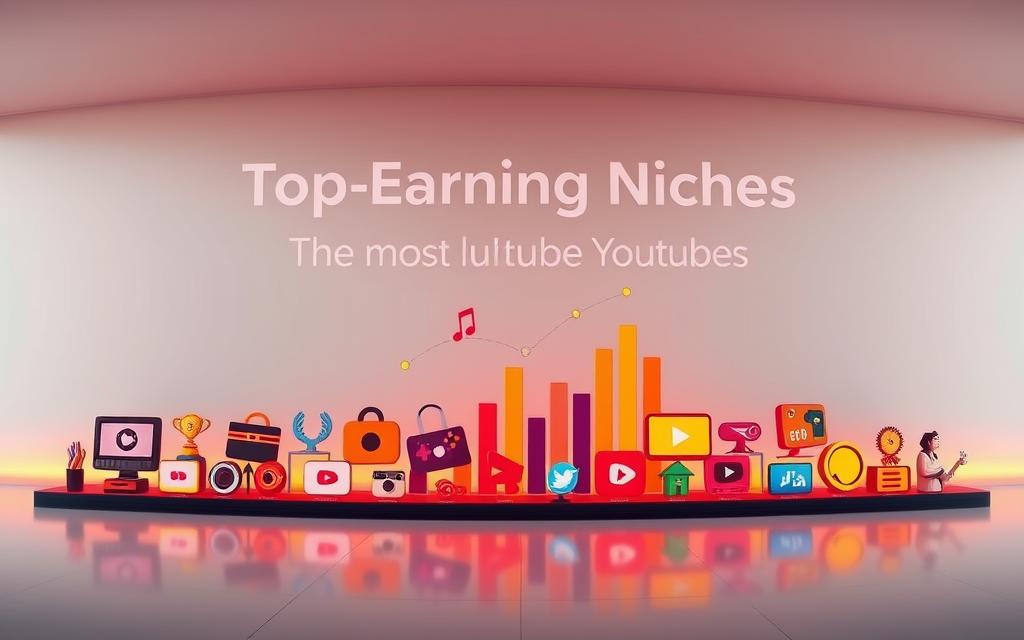
Educational Content
Evergreen demand makes educational content a stable earner. Channels like Blippi report $5–$15 CPMs due to high advertisers trust. Tutorials and how-tos retain value for years, unlike trend-driven topics.
Technology Reviews
Tech reviewers like Marques Brownlee leverage unboxing videos and affiliate links. With RPMs reaching $20, this audience attracts premium brands. A single viral review can generate $4K–$10K per million views.
Gaming Channels
Despite 125 billion annual views, gaming’s CPMs lag at $2–$5. Loyal fanbases offset lower ad rates through merch and sponsorships. Tip: Live streams boost Super Chat earnings.
Travel Vlogging
Post-pandemic recovery pushed travel RPMs to $2–$7. Destination guides and adventure videos perform well, especially with hotel and gear sponsorships. Seasonal peaks align with vacation planning.
Fitness & Health
Supplement brands drive this niche, offering $2K–$8K per million views. Trainers like Sanne Vloet partner with wellness companies for long-term deals. High engagement offsets moderate CPMs.
“Tech reviewers earn 3–5× more from affiliates than ads alone.” — Industry Report
For deeper insights, explore the most profitable YouTube niches and their revenue models.
Critical Factors Affecting Your Earnings
Your YouTube earnings depend on more than just view counts—multiple hidden factors shape your paycheck. From audience location to video structure, small adjustments can significantly boost revenue. Here’s what separates high-earning creators from the rest.

Viewer Geography Impact
Not all viewers generate equal income. Advertisers pay premium rates for audiences in North America and Europe. For example, a U.S. viewer typically delivers 5–10x higher RPM than one in India.
Localization strategies matter. Channels like AIR Media-Tech increased earnings by 35% by tailoring content to English-speaking countries. Holiday seasons further amplify gaps, with retail niches seeing CPM surges in Western markets.
Content Length Strategies
Videos under 8 minutes miss mid-roll ads, a key revenue stream. The sweet spot? 8–15 minutes. This length balances watch time and ad eligibility.
Educational and tech-review channels excel here. Longer tutorials retain viewers, triggering more ad breaks. Case studies show a 20% revenue jump when creators extend videos strategically.
Ad Placement Optimization
Natural pause points—like scene transitions—boost ad retention. YouTube requires 30-second watch time for ad qualification. Overloading breaks annoys audiences; spacing them every 3–5 minutes works best.
Pro Tip: Analyze audience retention graphs to identify drop-off points. Place ads just before these moments to maximize earnings without sacrificing engagement.
Beyond Ad Revenue: Alternative Income Streams
Smart creators know ad revenue is just the beginning of YouTube earnings. The platform offers multiple ways to generate income, from fan support to corporate partnerships. Diversifying your revenue streams creates financial stability against algorithm changes.
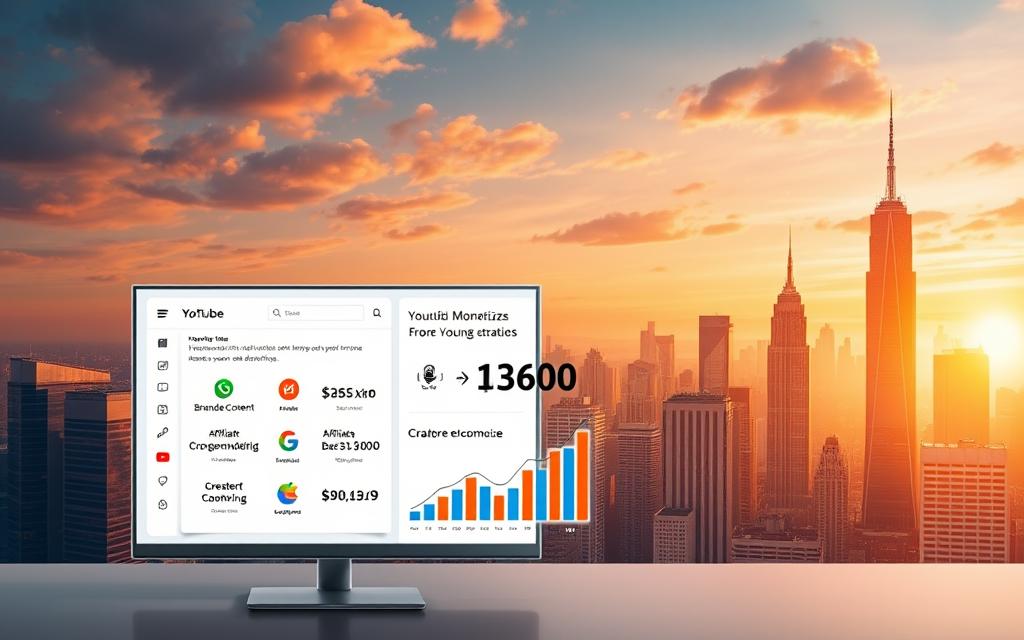
Channel Memberships
YouTube’s membership program lets fans support creators through monthly subscriptions. Tiers range from $4.99 to $99.99, offering perks like:
- Exclusive badges and emojis
- Members-only live streams
- Early video access
Gaming channels like VanossGaming report 12% of their money comes from these recurring payments. The key is delivering unique value that justifies the subscription cost.
Super Chat & Stickers
Live streams become profit centers with super chat features. Fans pay $1-$500 to highlight their messages during broadcasts. Popular ASMR artist Gibi ASMR earned $3,200 in one 3-hour stream through this system.
Stickers work similarly, with animated icons appearing beside comments. Both tools thrive on audience interaction—success requires building genuine community connections.
Brand Sponsorships
36.9% of marketers now use YouTube for affiliate campaigns, creating lucrative brand partnership opportunities. Common deal structures include:
- Flat fees per video ($500-$50,000)
- Revenue share on product sales
- Hybrid models with performance bonuses
Dude Perfect’s mobile game partnership demonstrates the potential—their sponsored content generated over $1M in six months. Always disclose sponsorships per FTC guidelines to maintain trust.
Merchandise shelves and digital products like presets or courses further expand earning potential. The most successful creators treat YouTube as a launchpad for broader business ventures.
Calculating Your Potential Earnings
Accurate revenue forecasting separates successful creators from hopeful amateurs. While YouTube’s algorithm remains unpredictable, strategic calculations help set realistic income expectations. Understanding these metrics transforms raw data into actionable insights.
CPM Estimation Tools
Google AdSense provides baseline earnings projections, but niche-specific tools offer deeper insights. AIR Media-Tech’s calculator factors in:
- Average watch time percentages
- Geographic audience distribution
- Historical CPM fluctuations
Finance channels typically see $16–$30 CPM, while gaming averages $2–$5. This 8x difference dramatically impacts revenue potential. Seasonal adjustments matter too—Q4 CPMs often spike 40% in retail niches.
Revenue Projection Models
Use this formula to estimate earnings:
Total Revenue = (Views × RPM × Monetization Rate) / 1,000
Key variables include:
| Factor | Range | Impact |
|---|---|---|
| Monetized Views | 65–80% | Reduces total eligible views |
| RPM | $1–$30 | Primary earnings driver |
| Watch Time | 40–70% | Affects mid-roll ad eligibility |
For hybrid income streams, add 30–50% to ad revenue projections. Sponsorships often triple total earnings for mid-sized channels. Equipment ROI typically breaks even at 500K views for professional setups.
Case Study: Travel creator Kara and Nate achieved 92% projection accuracy by weighting audience geography—their 60% U.S. viewership doubled estimated CPMs compared to global averages.
Seasonal Fluctuations in YouTube Revenue
Strategic creators align content production with high-earning periods. Advertising budgets and viewer behavior create predictable revenue cycles throughout the year.
Holiday Advertising Boosts
Q4 delivers the most significant earnings spike. Retail marketing budgets drive CPM increases up to 40% from November to December.
Black Friday through Christmas sees premium ad rates for:
- Gift guides and product reviews
- Holiday-themed entertainment
- Shopping tutorial content
“Our December RPMs consistently triple summer averages due to luxury brand campaigns.” — Tech Reviewer Sarah Dietschy
Niche-Specific Peak Periods
Different categories thrive at various times. Fitness channels gain 25% higher CPMs in January as viewers pursue New Year resolutions.
Other seasonal opportunities include:
- Back-to-school: August peaks for educational content
- Tax season: Financial advice surges in March-April
- Summer travel: June-July demand for vlogging
Smart creators use content calendars to capitalize on these factors. Planning six months ahead ensures timely video releases during high-value windows.
Video Format Impact: Shorts vs. Long-Form
YouTube creators face a crucial choice between short-form and long-form content strategies. Each format offers unique advantages for monetization and audience growth. Understanding these differences ensures optimal revenue from your videos.
Shorts Monetization Changes
YouTube Shorts now reaches 1.5B monthly users, but earnings differ from traditional videos. Key factors include:
- RPM gap: Shorts average $0.05–$0.07 RPM, while long-form earns $3–$30.
- Vertical ads limit placement options, reducing CPM by 60% vs. horizontal formats.
- The Shorts Fund pays creators for top-performing content, but requires 10M views in 90 days.
“Our 60-second Shorts retained 70% of viewers, doubling revenue over 15-second clips.” — Creator Case Study
Optimal Video Length for Ads
Long-form content (8+ minutes) unlocks mid-roll ads, significantly boosting revenue. Retention rates drop below 50% after 10 minutes, so balance length and engagement.
| Metric | Shorts | Long-Form |
|---|---|---|
| Avg. RPM | $0.06 | $8.50 |
| Ad Formats | Bumper only | Pre/mid/post-roll |
| Retention Rate | 70% | 50% |
Pro Tip: Repurpose long-form clips into Shorts teasers to drive traffic. Hybrid strategies maximize both discovery and earnings.
Audience Engagement Strategies
Strategic content design keeps audiences watching longer. High retention rates signal quality to YouTube’s algorithm, boosting visibility and ad revenue potential. Mastering these techniques transforms casual viewers into loyal followers.
Watch Time Optimization Tactics
Engineer compelling hooks within the first 15 seconds. This critical window determines whether viewers stay or click away. Use teasers, questions, or surprising facts to capture attention immediately.
Chapter markers improve navigation, letting users jump to valuable sections. This feature increases average watch time by 12% according to YouTube’s data. Place strategic cliffhangers before ad breaks to maintain interest.
Series content builds habitual viewing. Loyalty develops when audiences anticipate regular installments. Case studies show channels using this approach gain 20% longer watch times.
Encouraging Positive Ad Experiences
Test different ad frequencies to find the sweet spot. Too many interruptions drive audience away, while too few limit earnings. Place ads at natural pause points like topic transitions.
Interactive elements boost engagement:
- Polls during live streams
- Quizzes in descriptions
- Response requests in end screens
“Our mid-roll retention improved 18% by placing ads after key revelations rather than randomly.” — Educational Creator Team
Clear calls-to-action guide viewers through the desired journey. Whether subscribing, commenting, or watching another video, direct instructions work best. Survey your audience regularly to refine formats and pacing.
Technical Optimization for Higher Revenue
Mastering technical details can dramatically boost your YouTube revenue streams. Precision in ad placements and thumbnail design often separates high-earning channels from the rest. These optimizations require data analysis but yield measurable results.
Strategic Ad Break Placement
Manual ad breaks outperform automatic settings by 22% in retention. Identify natural pause points—scene transitions or topic shifts—using YouTube’s heatmap tool. Mid-roll ads perform best when placed every 3–5 minutes.
Avoid interrupting key moments. For example, tech reviewer Jonathan Morrison increased revenue 15% by aligning ads with product comparisons. Test different frequencies to balance earnings and viewer experience.
Thumbnail & Title Best Practices
High-converting thumbnails use:
- Contrasting colors (red/yellow) for mobile visibility
- Faces showing emotion (68% higher CTR)
- Minimal text (3 words max)
Titles should integrate keywords naturally. Case Study: Travel creator Erik Conover achieved a 300% CTR boost by A/B testing bold fonts against scenic backgrounds. Mobile-first design is critical—60% of viewers watch on phones.
“Our playlist strategy extended average watch time by 8 minutes, triggering more mid-roll opportunities.” —
End screens with related video suggestions further extend sessions. Combine these tactics with SEO-optimized descriptions for maximum algorithmic favor.
Common Monetization Mistakes to Avoid
Monetization missteps can derail even the most promising YouTube channels. Understanding platform policies and audience tolerance separates sustainable earners from those facing penalties or demonetization. Strategic creators balance revenue opportunities with viewer experience.
Ad Overload Pitfalls
Excessive ad breaks trigger viewer abandonment. Data shows channels using 3+ mid-rolls experience 18% lower retention rates. The sweet spot? One pre-roll and 2-3 mid-rolls for 10-minute videos.
Consider these factors when placing ads:
- Natural pause points increase completion rates
- Mobile viewers tolerate fewer interruptions
- Educational content supports higher ad density
| Ad Frequency | Retention Impact | Revenue Change |
|---|---|---|
| 1 mid-roll | +5% | -12% |
| 3 mid-rolls | -18% | +22% |
| 5 mid-rolls | -34% | +9% |
Content ID Claims
Copyright strikes disable monetization instantly. Many creators misunderstand fair use doctrine, risking channel termination. Always secure music licenses or use royalty-free tracks.
Common pitfalls include:
- Background music in public spaces
- Game footage without commentary
- Reused content from other creators
“We recovered 92% of disputed claims by providing commentary timestamps proving transformative use.”
YouTube’s spam policies flag excessive tags or misleading thumbnails. These violations often trigger manual reviews, delaying ads approval. Regular policy checks prevent unexpected revenue drops.
Conclusion
Building a profitable YouTube channel requires strategy and patience. While ad revenue averages $3K-$5K per million plays, top creators earn far more through diversified income streams.
Focus on your niche’s strengths. Tech and finance content often delivers higher money per view than entertainment. Use analytics tools to track performance and optimize ad placements.
Stay ahead by exploring new formats like VR and AI-assisted content. Many successful channels combine Shorts for discovery with long-form videos for deeper engagement.
Ready to grow? Audit your channel today. Check watch time, geographic data, and RPM trends. Small tweaks can significantly boost earnings over time.
Every viral creator started with zero views. With consistent effort and smart monetization, your channel can achieve similar success.
FAQ
What is the difference between CPM and RPM on YouTube?
CPM (Cost Per Mille) measures what advertisers pay per 1,000 ad impressions, while RPM (Revenue Per Mille) shows what creators earn after YouTube’s 45% cut. RPM is always lower than CPM.
How does the YouTube Partner Program revenue split work?
YouTube keeps 45% of ad revenue, while creators receive 55%. This applies to all monetized content through the Partner Program.
Which YouTube niches generate the highest earnings?
Finance, technology reviews, and business education typically have the highest CPM rates. Gaming and vlogging often earn less per view but can scale through volume.
Why do earnings vary for creators with similar view counts?
Factors like audience location, content type, ad engagement, and video length create earnings differences. A U.S.-based tech channel often earns more than a global gaming channel with equal views.
When do YouTube creators see seasonal revenue spikes?
Q4 (October-December) brings the highest ad rates due to holiday marketing. Some niches like back-to-school content peak in August/September.
Can YouTube Shorts generate significant revenue?
Since February 2023, Shorts earn through a separate revenue-sharing pool. While payouts are lower than long-form videos, viral Shorts can still generate substantial income.
What are the most common monetization mistakes?
Overloading videos with mid-roll ads often hurts retention. Ignoring Content ID claims can also lead to lost revenue from copyright issues.
How do brand sponsorships compare to ad revenue?
Sponsored segments often pay 5-10x more than ad revenue for the same views. Top creators frequently earn more from sponsorships than YouTube’s ad share.
What’s the minimum watch time for monetization?
Channels need 4,000 public watch hours in the last 12 months or 10 million Shorts views in 90 days, plus 1,000 subscribers to qualify for monetization.
How does audience location impact earnings?
Views from the U.S., Canada, and Western Europe typically earn 5-10x more than views from developing markets due to higher advertiser demand.


